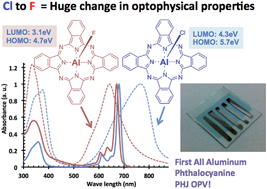From chloro to fluoro, expanding the role of aluminum phthalocyanine in organic photovoltaic devices†
Abstract
Fluoro aluminum phthalocyanine (F-AlPc) was synthesized by simply heating a DMSO solution of chloro aluminum phthalocyanine (Cl-AlPc) in the presence of CsF, KF or NaF for less than an hour. The resulting F-AlPc has a significant blue shift in the absorbance of ≈8 nm in solution and ≈130 nm in a solid film compared to Cl-AlPc. Ultraviolet photoelectron spectroscopy (UPS) identified a change in work function and EHOMO of as much as 1 eV between Cl-AlPc and F-AlPc. Our observed change in UPS data, solid-state absorbance and sublimation temperature for F-AlPc further confirms the stacked fluorine bridge solid-state structure for F-AlPc previously described by Kenney et al. Preliminary planar heterojunction (PHJ) organic photovoltaic (OPV) devices were then fabricated using F-AlPc as an electron donating material paired with C60 and a ternary device including a Cl-AlPc interlayer. Additionally, an all AlPc device where F-AlPc functioned as the electron donor and Cl-AlPc as the electron acceptor was fabricated. The EQE plots of the resulting PHJ OPV devices illustrate that an exciton-rectifying layer is present between the Cl-AlPc and F-AlPc layers in the ternary devices as well as the all AlPc device. These results further exemplify that the seemingly minor change from chloride to fluoride in the AlPc structure has significant implications in optoelectronic properties and functionality of AlPc in PHJ OPV devices.


 Please wait while we load your content...
Please wait while we load your content...